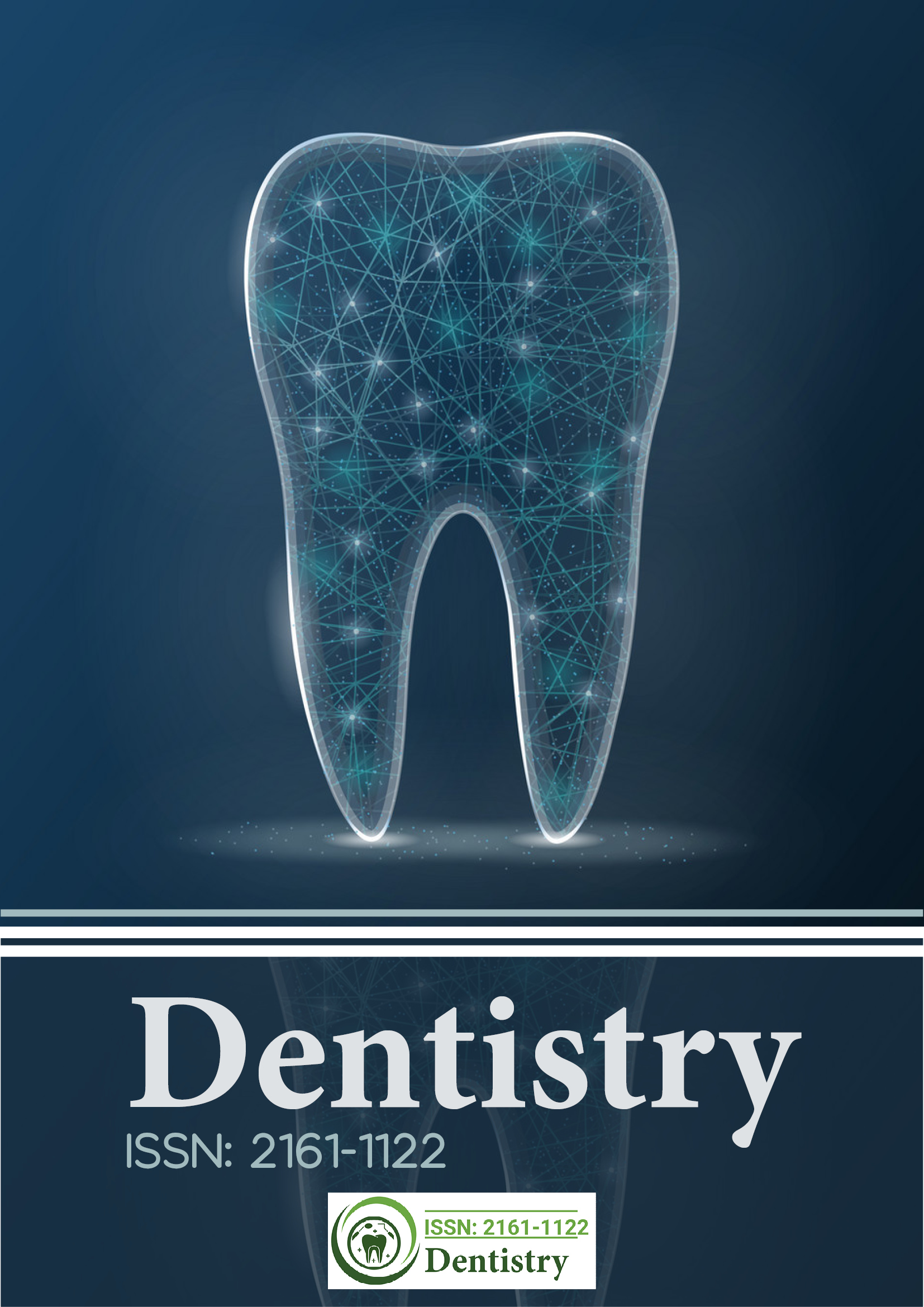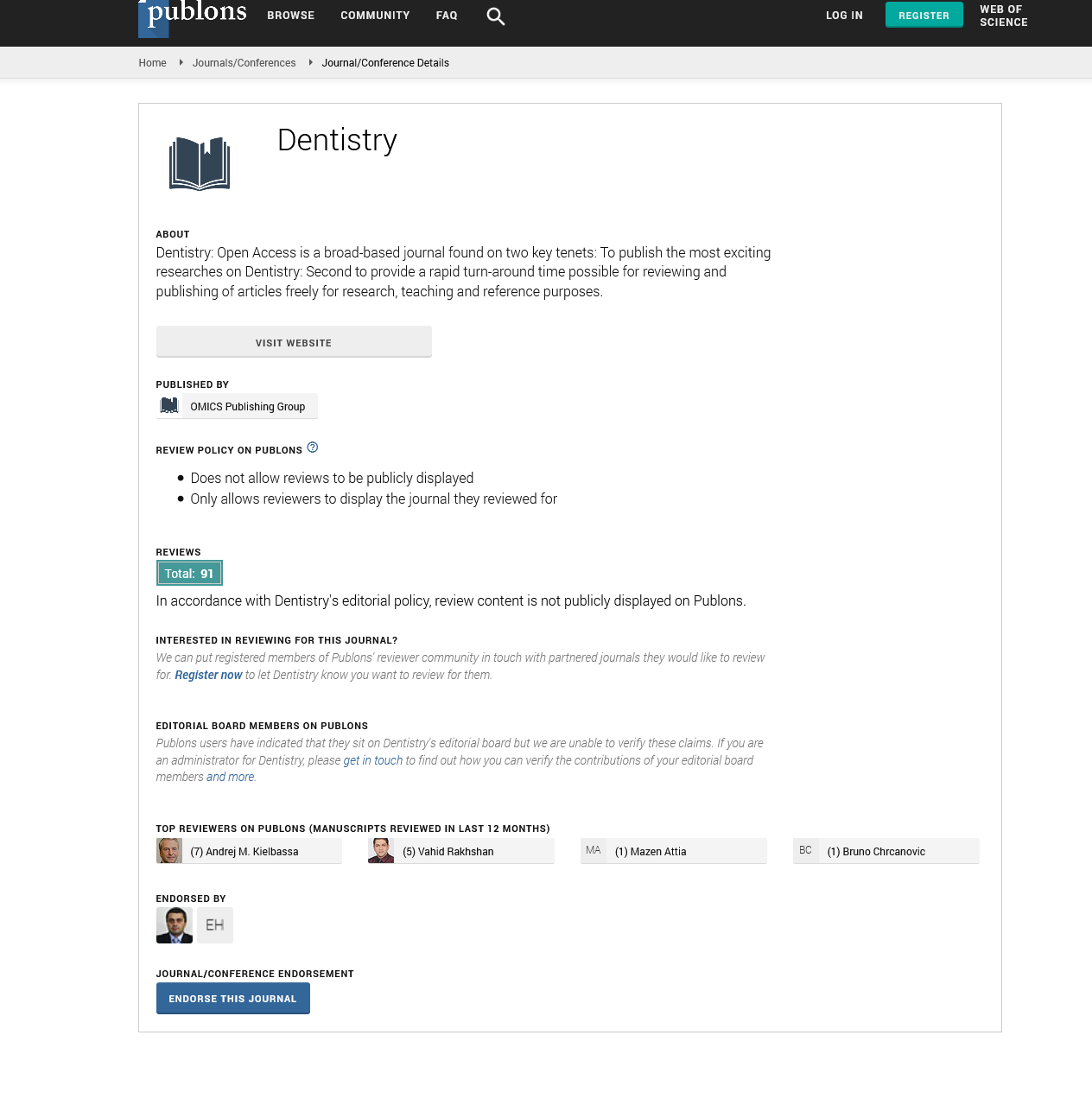Citations : 2345
Dentistry received 2345 citations as per Google Scholar report
Indexed In
- Genamics JournalSeek
- JournalTOCs
- CiteFactor
- Ulrich's Periodicals Directory
- RefSeek
- Hamdard University
- EBSCO A-Z
- Directory of Abstract Indexing for Journals
- OCLC- WorldCat
- Publons
- Geneva Foundation for Medical Education and Research
- Euro Pub
- Google Scholar
Useful Links
Share This Page
Journal Flyer

Open Access Journals
- Agri and Aquaculture
- Biochemistry
- Bioinformatics & Systems Biology
- Business & Management
- Chemistry
- Clinical Sciences
- Engineering
- Food & Nutrition
- General Science
- Genetics & Molecular Biology
- Immunology & Microbiology
- Medical Sciences
- Neuroscience & Psychology
- Nursing & Health Care
- Pharmaceutical Sciences
Opinion Article - (2024) Volume 14, Issue 2
Impact of Public Health Dentistry through Comprehensive Oral Care
Klaus Hesse*Received: 03-Jun-2024, Manuscript No. DCR-24-26163; Editor assigned: 05-Jun-2024, Pre QC No. DCR-24-26163 (PQ); Reviewed: 19-Jun-2024, QC No. DCR-24-26163; Revised: 26-Jun-2024, Manuscript No. DCR-24-26163 (R); Published: 03-Jul-2024, DOI: 10.35248/2161-1122.23.14.692
Description
Public health dentistry stands as a vital discipline within the broader field of dentistry, focusing on the prevention and control of dental diseases through community-based initiatives. This specialty integrates dental science with public health principles to improve the oral health of populations rather than individuals, recognizing that oral health is an acute component of overall health and well-being. The foundation of public health dentistry lies in the understanding that oral diseases, such as dental caries, periodontal diseases, and oral cancers, are not merely individual problems but widespread public health concerns. These conditions can lead to significant pain, discomfort, and even systemic health issues if left untreated. Furthermore, they impose substantial economic burdens on individuals and healthcare systems. Public health dentistry aims to mitigate these impacts through community-based interventions, policy advocacy, and education.
One of the primary goals of public health dentistry is to reduce the incidence and prevalence of dental caries, commonly known as tooth decay. Public health approaches to combating dental caries include water fluoridation, dental sealant programs, and community education on proper oral hygiene practices. Water fluoridation, the controlled addition of fluoride to public water supplies, is one of the most effective and cost-efficient measures for preventing dental caries. Dental sealants, another key preventive measure, involve applying a protective coating to the chewing surfaces of the back teeth, where decay often starts. Sealant programs are particularly beneficial for children, who are at higher risk of developing caries. Public health initiatives often target schools, providing sealants to children who might not otherwise have access to dental care. These programs have been shown to reduce the incidence of cavities by up to 80 percent in the treated teeth, demonstrating their effectiveness in promoting oral health.
Public health dentistry also places a strong emphasis on education and awareness. Educating the public about the importance of oral health and how to maintain it is fundamental to preventing dental diseases. Public health campaigns often focus on promoting regular dental check-ups, proper brushing and flossing techniques, and healthy dietary choices. By increasing awareness and knowledge, these campaigns empower individuals to take charge of their oral health, reducing the overall burden of dental diseases in the community. In addition to preventive measures, public health dentistry addresses the issue of access to dental care. Public health dentistry works to eliminate these barriers by advocating for policies that expand access to care, such as Medicaid coverage for dental services, community dental clinics, and mobile dental units that bring care to underserved areas.
Public health dentists also engage in epidemiological research to understand the patterns and causes of oral diseases within populations. This research is vital for identifying risk factors, evaluating the effectiveness of interventions, and informing policy decisions. For instance, studies on the link between oral health and systemic health have highlighted the importance of maintaining good oral hygiene to prevent conditions such as cardiovascular disease, diabetes, and adverse pregnancy outcomes. By providing evidence-based insights, public health dentistry contributes to a broader understanding of health and informs strategies to improve health outcomes. Moreover, public health dentistry involves collaboration with various stakeholders, including government agencies, non-profit organizations, schools, and community groups. These partnerships are essential for implementing comprehensive oral health programs and reaching diverse populations. Recognizing that oral health is an integral part of overall health, there is a growing movement to include dental care within the broader healthcare system.
Technology also plays a significant role in advancing public health dentistry. Through tele-dentistry, patients can receive consultations, diagnoses, and treatment plans from dental professionals without the need for in-person visits. This technology not only increases access to care but also facilitates ongoing monitoring and follow-up, ensuring continuity of care. Many public health initiatives rely on government funding, which can be subject to budget cuts and policy changes. Advocating for consistent and adequate funding is essential to maintain and expand public health dental programs. Additionally, addressing disparities in oral health remains a significant trials. Persistent gaps in access and outcomes between different socioeconomic and demographic groups highlight the need for targeted interventions and policies that address the root causes of these disparities. Through preventive measures, education, research, and policy advocacy, public health dentistry seeks to reduce the burden of dental diseases and promote overall health and well-being. By addressing the social determinants of health and ensuring equitable access to dental care, public health dentistry can create healthier communities and enhance the quality of life for all individuals. As the field continues to evolve, ongoing collaboration, innovation, and commitment to equity will be key to overcoming trials and achieving lasting improvements in oral health.
Citation: Hesse K (2024) Impact of Public Health Dentistry through Comprehensive Oral Care. J Dentistry. 14:692.
Copyright: © 2024 Hesse K. This is an open access article distributed under the terms of the Creative Commons Attribution License, which permits unrestricted use, distribution, and reproduction in any medium, provided the original author and source are credited.

